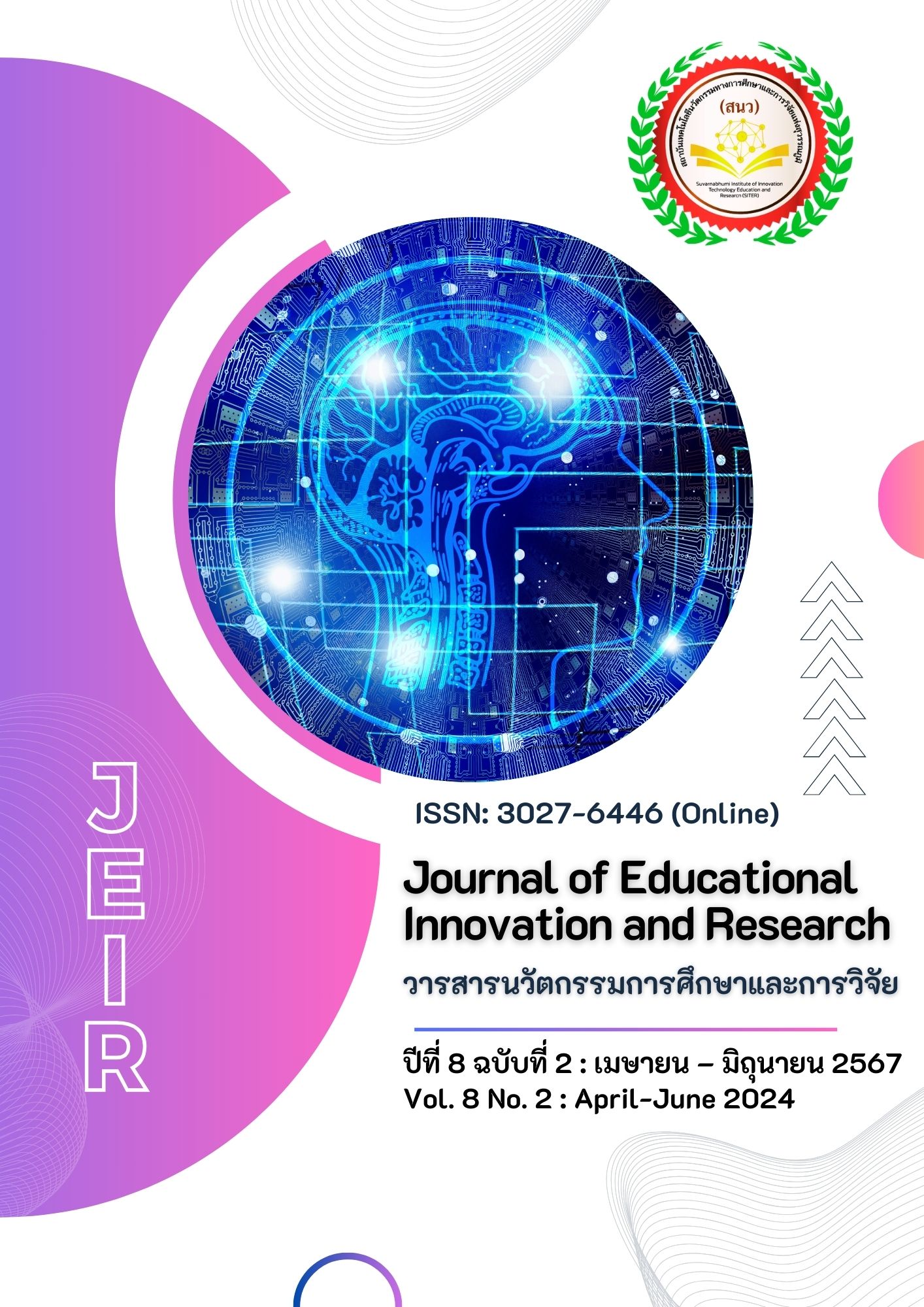การจัดการนวัตกรรมการให้บริการผู้โดยสาร ของท่าอากาศยานสุวรรณภูมิ
Main Article Content
บทคัดย่อ
รัฐบาลได้กำหนดให้ท่าอากาศยานสุวรรณภูมิเป็นท่าอากาศยานหลักของประเทศ เป็นศูนย์กลางทางด้านการบินในภูมิภาคอาเซียน มีบทบาทเป็น International Gateway โดยผลักดันให้เป็น Transit & Transfer Hub ของภูมิภาค จึงจำเป็นต้องมีการนำรูปแบบการบริหารจัดการนวัตกรรมการให้บริการผู้โดยสารที่มีประสิทธิภาพมาใช้ในการดำเนินงาน ให้สอดคล้องกับริบทการแข่งขันทางด้านการบินที่มีความรุนแรงในสถานการณ์ปัจจุบัน และรองรับการเปลี่ยนแปลงที่จะเกิดขึ้นในอนาคต การวิจัยนี้มีวัตถุประสงค์ 3 ประการ (1) เพื่อวิเคราะห์บริบทการจัดการนวัตกรรมการให้บริการผู้โดยสาร ของท่าอากาศยานสุวรรณภูมิ (2) เพื่อระบุปัญหาการจัดการนวัตกรรมการให้บริการผู้โดยสาร ของท่าอากาศยานสุวรรณภูมิ และ (3) เพื่อเสนอรูปแบบการจัดการนวัตกรรมการให้บริการผู้โดยสาร ของท่าอากาศยานสุวรรณภูมิ การวิจัยนี้เป็นการวิจัยเชิงคุณภาพ ผู้ให้ข้อมูลสำคัญ จำนวน 16 คน ได้แก่ พนักงาน บริษัท ท่าอากาศยานไทย จำกัด (มหาชน) จำนวน 6 คน และผู้โดยสารที่มาใช้บริการท่าอากาศยานสุวรรณภูมิ จำนวน 10 คน เก็บรวบรวมข้อมูลโดยใช้การสัมภาษณ์เชิงลึก และการสังเกตการณ์แบบมีส่วนร่วมและไม่มีส่วนร่วม วิเคราะห์ข้อมูลโดยการวิเคราะห์แก่นสาระ
ผลการวิจัย (1) บริบทการจัดการนวัตกรรมการให้บริการผู้โดยสาร ประกอบด้วย นโยบาย หลักเกณฑ์ หลักการ กระบวนการดำเนินงาน และหน่วยงานที่รับผิดชอบด้านการจัดการนวัตกรรม (2) ปัญหาการจัดการนวัตกรรม ประกอบด้วย (2.1) ด้านผู้นำองค์กร พบว่า การตัดสินใจล่าช้าไม่สอดคล้องกับบริบทการเปลี่ยนแปลงเนื่องจากมีหลายขั้นตอนในการดำเนินงาน (2.2) ด้านกลยุทธ์องค์กร พบว่า การนำกลยุทธ์มาปฏิบัติล่าช้า เนื่องจากผลกระทบจากวิกฤติโควิด – 19 ที่มีการปิดน่านฟ้าทั่วโลก (2.3) ด้านการมีส่วนร่วม พบว่า พนักงานในระดับปฏิบัติขาดการมีส่วนร่วมในการตัดสินใจ (2.4) ด้านวัฒนธรรมองค์กร พบว่า ระบบอุปถัมภ์เป็นอุปสรรคที่สำคัญในการนำนวัตกรรมมาใช้ (2.5) ด้านโครงสร้างองค์กร พบว่า โครงสร้างขององค์กรที่มีขนาดใหญ่ ยึดติดกับระบบราชการ ทำให้เกิดความล่าช้าในการดำเนินงาน และ (3) รูปแบบการจัดการนวัตกรรมการให้บริการผู้โดยสาร คือ การริเริ่มในประเด็น ดังนี้ (3.1) ผู้นำต้องเป็นมืออาชีพ มีภาวะผู้นำเชิงยุทธศาสตร์ เป็นนักบริหารการเปลี่ยนแปลง (3.2) มีการวางแผนกลยุทธ์ให้ชัดเจน ให้สอดคล้องกับบริบทของสิ่งแวดล้อมที่มีการเปลี่ยนแปลง (3.3) เปิดโอกาสให้ผู้มีส่วนได้เสียได้มีส่วนร่วมในการจัดการนวัตกรรม (3.4) สร้างค่านิยมที่เหมาะสมต่อการพัฒนาองค์กร ความรู้คู่คุณธรรม และ (3.5) โครงสร้างขององค์กรต้องมีขนาดที่เหมาะสม ไม่เป็นภาระงบประมาณ ระบบสื่อสารที่ชัดเจน
Article Details

อนุญาตภายใต้เงื่อนไข Creative Commons Attribution-NonCommercial-NoDerivatives 4.0 International License.
เอกสารอ้างอิง
Airports of Thailand Public Company Limited. (2021). AOT's enterprise plan (fiscal year 2017 - 2022). Review edition. http://www.oic.go.en/FILEWEB/CABINFOCENTER6/DRAWER007/GENERAL/DATA 0000/ 00000119.PDF
Airports of Thailand Public Company Limited. (2023). Values of AOT, Airports of Thailand Public Company Limited. https://www.airportthai.co.th
Chutiwong, N. and Kerdsri, N. (2011). Analysis of factors influencing being an innovative organization in Thailand. Journal of the Faculty of Commerce and Accountancy, Thammasat University, Thammasat, 34(130), 47-52.
Cordupleski, Rust, and Zahorik. (1993). Organization Behavoior a Times Mirror Higher. New York: Education Group Inc, company.
Cronin, J.J. and Taylor, S.A. (1992), Measuring service quality: a reexamination and extension. Journal of Marketing, 56, 55-68.
Crosby. (1982). The Eternally Successful Organization. New York: McGraw-Hill.
Damanpour, F. (1987). The Adoption of Technological, Administrative, and Ancillary Innovations: Impact of Organizational Factors. Journal of Management. 13(4), 675-688.
Dubrin, A. J., & Ireland, R. (1993). Management and organization. (2nd ed.). Ohio: South Westem Publishing Company.
Fayol, H. (1949). General and Industrial Management. London: Sir Isaac Pitman & Sons.
Freeman, C. & Soete, L. (1997). The Economics of Industrial Innovation. 3rd ed. London: Continuum.
Grönroos, C. (1984). A Service Quality Model and its Marketing Implications. European Journal of Marketing,18(4), 36-44. https://doi.org/10.1108/EUM0000000004784
Gulick, L.r & Urwick, L. (1973). The Science of Administration. New York: Columbia University.
Herkema, S. (2003). A Complex Adaptive Perspective on Learning with in Innovation Projects. The Learning Organization, 10(6), 340- 346.
Jain, K. & Mengist Hailemariam. (2010). Managing Airport Supply Chain: an Ethiopian case study. Indian Institute of Technology Bombay, India. https://www.pomsmeetings.org/confpapers/015/ 015-0557.pdf
Lewis, and Bloom, Benjamin S. (1983). Human Characteristics and School Learning. New York: Mc Grew – Hill Book.
Paeharoen, C., Pinthapataya, S., Boonyasopon, T. and Teeraviwatchai, A. (2017). The Management of the Commercial Areas of the International Airports in Thailand. The Journal of KMUTNB.,27(1),179 – 186.
Pakdeelao, W. (2011).The Study of Characteristics of Innovative Organization: Case Studies from Awarded Organizations [Master’s Thesis, National Institute of Development Administration].
Rogers, E.M. (1995). Diffusion of Innovations. 4th ed. New York: Free Press.
Schumpeter, J. A. (1942). Capitalism, Socialism, and Democracy, Harper & Brothers. New York: Transaction Publishers.


